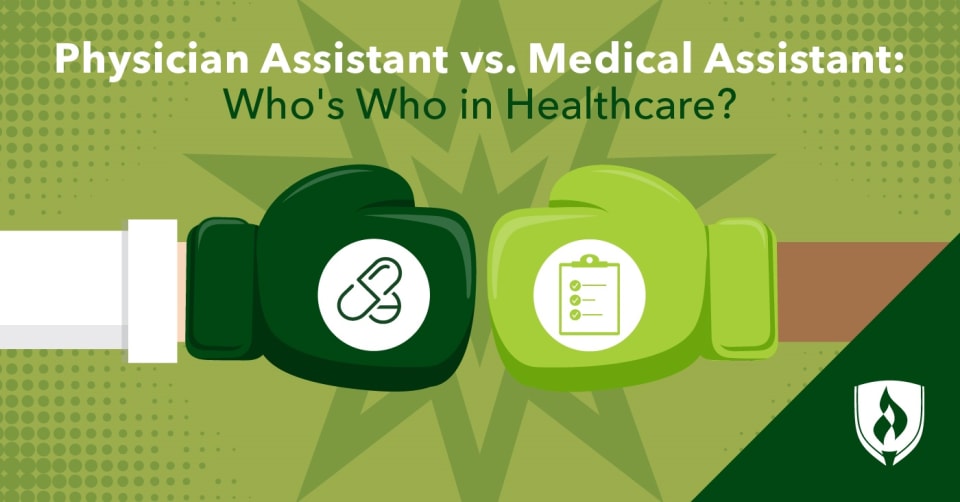
The medical field is filled with a wide variety of seemingly similar job titles, and if you’re not completely tuned in to the healthcare field, it can be pretty easy to get confused. The job titles “physician assistant” and “medical assistant” can be a particularly confusing combo. They both have “assistant” in the title and work directly with patients—but there are also major differences between the two.
Whether you’re interested in entering the medical field yourself or are just looking to cure a curiosity about these roles, you’re in the right place. In this article, we’ll take a closer look at both of these roles and compare the differences between a medical assistant (MA) and a physician assistant (PA) so you’ll have the record set straight.
Physician assistant vs. medical assistant: Scope of practice
Though PAs and MAs both deliver primarily direct patient care, the type of work they do is significantly different. Medical assistants perform more entry- or mid-level patient care duties like taking patient vitals, reviewing the patient’s allergies and medications, taking and reviewing patient histories and scheduling appointments. PAs, on the other hand, are trained in the same medical model of practice that physicians are and perform duties closer in alignment to that of a doctor—like diagnosing patients, performing exams and ordering tests and treatments. Let’s look into each role’s responsibilities a little more.
What does a physician assistant (PA) do?
PAs provide a range of physician-level medical services under the supervision of a doctor. While this might sound like a doctor is always looking over their shoulders, in practice PAs work relatively independently and only consult with doctors as needed. Their work often includes conducting examinations, developing treatment plans and, in many cases, even qualifies them to interpret diagnostic tests and prescribe some medications, according to the Bureau of Labor Statistics.1 In fact, PAs are increasingly being utilized to fill gaps in medical coverage in rural or other underserved locations where there is often a shortage of qualified physicians.
It should be noted that the laws for PAs guiding factors like scope of practice, level of physician supervision, prescription authority and more are not uniform across states. Some states offer PAs more independence, while others may be more conservative.
What does a medical assistant (MA) do?
Medical assistants have a combination of clinical and administrative duties that support a physician’s work. Much of their work comprises prepping the patients to see the doctor or “rooming” the patient and can include duties like recording a patient’s medical history, taking vital signs and collecting laboratory specimens.
In most states, medical assistants can also administer medication and give injections, though these duties may depend on training and the state you work in.
Physician assistant vs. medical assistant: Education or training needed
Given the differences in responsibilities for PAs and MAs, it shouldn’t come as a surprise that these two positions vary greatly in the amount of education and training needed to get started in them. Both will require education beyond the high school classroom, but PAs will need significantly more.
Physician assistant (PA) education
The timeline for completing a physician assistant education can be upwards of six years. All states require a physician assistants to obtain a master’s degree from a school with an accredited PA program followed by licensure. Entry requirements for most PA programs will include earning a bachelor’s degree, experience shadowing a practicing physician assistant and a certain number of paid patient care hours. Working as a medical assistant, EMT, patient care aide or certified nursing assistant are all great ways to accumulate the experience necessary to apply.
The requirements for obtaining licensure to work as a PA will vary depending on the state, but all states do require would-be PAs to pass the Physician Assistant National Certifying Exam (PANCE). Additionally, physician assistants typically need to meet continuing education hours requirements to maintain licensure.
Medical assistants (MA) education
Medical assistant roles require significantly less training compared to PAs. Most states do not have formal education requirements, but many employers prefer to hire assistants who have completed an accredited training program, according to the BLS.2
These programs typically require a much smaller time investment. The Medical Assisting Diploma program at Rasmussen University, for example, can be completed in as few as 12 months.3 While states may not require medical assistants to obtain certification, many employers may prefer it. For those who pursue certification, they’ll need to graduate from a recognized medical assisting program and complete a certification exam to complete the process.
Physical assistant vs. medical assistant: Which career fits you?
As you can see, while both occupations play an important role in providing patient care, these pieces of the puzzle are used in different areas of the healthcare hierarchy. Physician assistants require substantially more training and education to get started, but they also have higher earning potential and broader responsibilities. The path to becoming a medical assistant is much shorter and can be an excellent option for anyone seeking a relatively simple entry-point into the healthcare field.
Now that you know more about the differences between these similar sounding healthcare careers, does becoming a medical assistant sound like it could be the right fit for you? Find out more in our article, “7 Signs You'd Thrive in a Medical Assisting Career."
Related Articles:
1Bureau of Labor Statistics, U.S. Department of Labor, Occupational Outlook Handbook, Physician Assistants [accessed December, 2020] https://www.bls.gov/ooh/healthcare/physician-assistants.htm. Information represents national, averaged data for the occupation listed and includes workers at all levels of education and experience. Employment conditions in your area may vary.
2Bureau of Labor Statistics, U.S. Department of Labor, Occupational Outlook Handbook, Medical Assistants [accessed December, 2020] https://www.bls.gov/ooh/healthcare/medical-assistants.htm. Information represents national, averaged data for the occupation listed and includes workers at all levels of education and experience. Employment conditions in your area may vary.
EDITOR'S NOTE: This article was originally published in 2014. It has since been updated to include information relevant to 2021.




